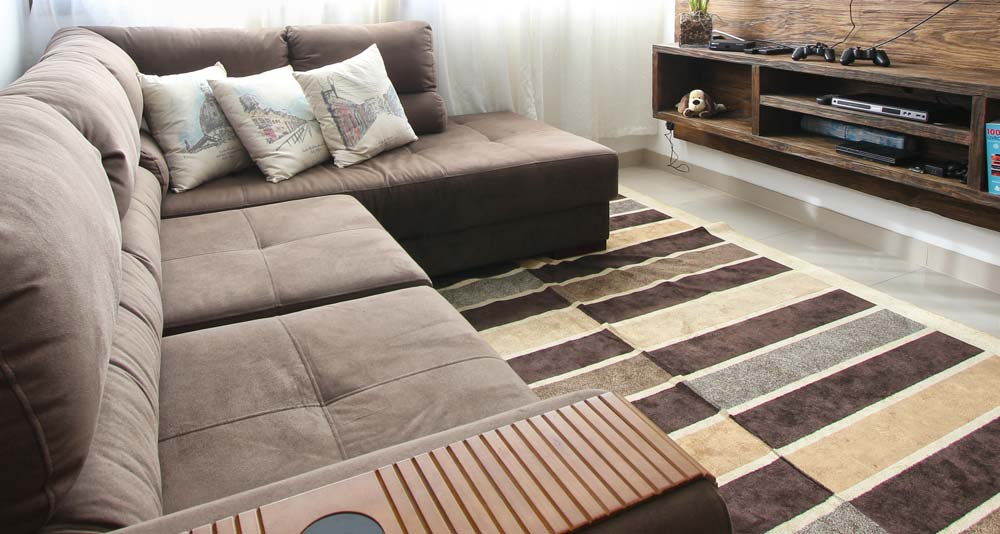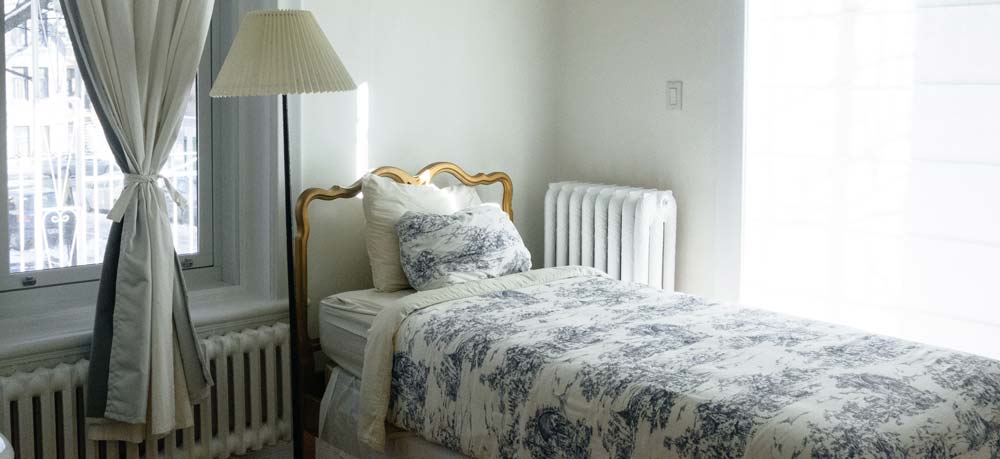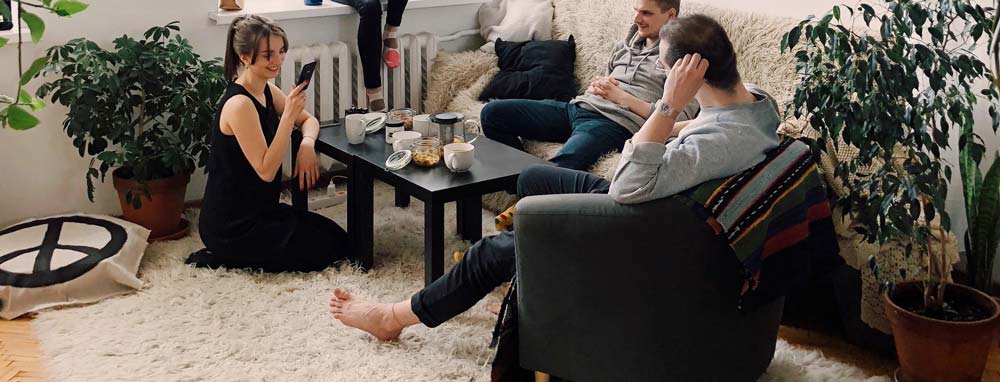5 Ways to Reduce Noise in a Rental
Looking to reduce noise in a rental building? Read on to find out our top 5 suggestions for apartment living.
More people live in apartments in the U.S. in this decade than they have since at least the mid-1960s, according to a Pew Research Center analysis. As of 2024, over 44 million Americans are home renters and the Census Bureau’s housing data shows the number of people living in rentals is still climbing.

Even though plenty of Americans prefer single-family dwellings and eventually want to buy a home, apartment life can have wonderful perks: plenty of neighbors, city life booming all around you, no need for upgrades and maintenance out of your own pocket. In most cases, you get the benefits of less space to clean and lower utility bills. You may even have the added comfort of on-site amenities and better security!
The downsides?
Neighbors. Are they seriously having a party at 3 AM?
City life. They are STILL working on the street outside my window — it’s been six weeks!
Maintenance. Those pipes just never stop clanging. Why are these walls so thin??
The annoying noise can suck your soul dry of all the good and holy peace you need to relax and (quietly, of course) binge Netflix for hours after a long day at work.
Want to restore the peace? Here are 5 simple tips for soundproofing and sound absorption in your apartment rental to help eliminate exterior and interior noise.
How to Reduce Noise in a Rental
1. Check the Doors
Reducing sound leaks from the space around the doors is easy and typically inexpensive. Take a look at all the doors in your apartment, including interior ones. Fixing the gaps and creating a seal for doors will help reduce sounds coming both from exterior and interior sources.
If your doors don’t have draft blockers or door sweeps, add those first. For picky management, stick with the fabric-style insulators that simply slip into the space between the door and the floor. These are easy to use and can be removed quickly with zero damage to the door. Door sweeps may require screws, so if modifications aren’t allowed, skip that style and opt for a vinyl door bottom with fins that slides on. With both fabric-style and heavier duty sweeps, creating a no-gap seal is important.
Go a step further with your soundproofing to reduce noise in a rental by adding on silicone adhesive-backed gasketing strips around the door frame. This creates a tighter seal that blocks out even more sound. Silicone will work better and last longer than foam for this application.
Floor mats with rubber backing can also be useful here. Adding one to a thin door can help dampen sounds coming into your apartment. Bonus tip: DIY a pattern with a stencil and paint to add appeal to an otherwise plain mat, coordinating it with the rest of your apartment décor.

2. Add Art, Tapestries, Panels
Did you hang a blanket in your dorm room just because it looked so cool? While that may have reflected your style as an on-campus college freshman, you have more options now that can be beautiful and serve a nobler purpose: soundproofing too-thin walls.
Adding drywall or a temporary wall might provide the best results for reducing noise in a rental, but you may not be able to change the structure in an apartment rental. To block out and absorb undesirable sound coming through the walls, hanging up art and tapestries can be the next best thing. You can cut down on noise AND get your deposit back when you move! These pretty pieces of fabric will reduce incoming sounds, so look for complementary wall hangings you can safely mount. You’ll have the added benefit of the tapestry reducing sound reflections in the apartment as well.
Art
Picking out and hanging canvas art on the walls can also help with soundproofing your entire rental space. Ask a framing service to add foam core to the back for even more sound absorption, though even just the framed art itself can help.
Curtains
Similar to a tapestry, hanging thick, decorative curtains on your walls can also deaden the outside noise. Since thick curtains can be heavy, use appropriate hardware and a thicker metal rod made to hold more weight.
Acoustic Panels
Another option that can reduce internal & external noise from walls is using acoustic panels. These panels are designed to eliminate sounds and can help with noise reflection as well. Modern acoustic wall and ceiling panels will give you sound blocking and sound absorption. Attaching acoustical panels to the ceiling can deaden those loud neighbors on the level above. Hanging acoustic panels can break up reflected noise coming from inside your apartment, too.

3. Put up Window Treatments
Unless you can convince management of the benefits of double- or triple-pane window installations, you’ll probably have to go an easier route for soundproofing your windows.
Similar to the walls, adding fabric is going to be your best non-destructive choice. If the windows are completely bare, go all out with fabric shades, sheer curtains, and heavy drapes.
Fabric shades are a better option than harder surfaces like wood or plastic since they will absorb sound more efficiently instead of bouncing it around. The thicker the drapes, the better, so opt for a plush fabric with a tight weave for the windows. If you can’t afford to add all three, stick with the heavy drapes at the minimum.
Bonus Tip: more sound insulation on the windows might just save you a few bucks on your electric bill. Win, win.
4. Soften Hard Floors
While polished wood or natural stone tile may look beautiful to your eyes, it won’t do anything to make your ears happy. Hard-surface flooring reflects interior sounds, causing the ambient levels to increase. Since you probably aren’t allowed to roll out wall-to-wall carpet in your abode, lay down smaller sound-absorbing décor instead! Rugs are an easy way to reduce noise in an apartment without modifications to the structure, plus you’ll add interest and value to the room’s aesthetic.

Choose a thicker acoustic rug, with a unique design, over a thinner one for the most soundproofing. Shoes and furniture make less noise on rugs, so the sounds of sliding chairs and heels are softened to a pleasant swish instead of loud scrapes and clangs. Rugs can also help reduce the noise coming from your apartment that neighbors might hear. To maximize a rug’s noise-killing potential without taking away your apartment’s square footage, look at adding a pad under the rug.
If you have small children, foam floor tiles are also a good option for quietening down hard flooring in the play area. Not only do they dampen sounds, removable floor tiles are usually easier to clean than carpet.
5. Evaluate the Whole Room
Apartment living can make it easy to live with minimal possessions, but empty spaces love to amplify sound. The less you have filling up your open spaces, the more both exterior and interior sound will bounce around. How can you fix that?

To start, take a look at your furniture: is it hard and minimal? If so, replace it when you can with plush, upholstered furniture instead. Hard materials may give you the aesthetic you desire, but you’ll be lacking that necessary peace and quiet. Opt for throw pillows (so they DO have a purpose!) and plenty of cozy blankets on couches, beds, and other seating to help absorb sounds and discourage noise from reflecting back into the room.
For minimal furniture setups, keep the blankets and pillows out in decorative baskets instead. If your friends inquire about why you have them, just tell them it’s science and stare at them for a minute without blinking. They’ll move on because of the quiet space you’ve created.
Another way to add soundproofing and sound absorption to a room is with bookshelves filled with books. Sure, you can read everything you want in digital format now, but books are great for both absorbing and blocking noise. Avoid shelves with glass or hard fronts and go with open shelves that show off your collection instead to further reduce noise in your apartment.
The final step to improving your apartment’s ambiance is with greenery from plants. Live indoor plants can help break up open space that might otherwise push sound back into the room, causing unnecessary sound. The waxy, humid-loving peperomia plant, which does well under fluorescent lighting, might be a good choice for the kitchen, while dragon tree plants work well in low-light areas (be aware — the dracaena marginata is toxic to cats and dogs). The pothos plant is a good one to suspend from ceilings — another way to break up reflected sound! And, of course, plants can provide the added bonus of better air quality and liveliness of greenery.

Enjoy Your Tranquil Rental Space with Unika Vaev
Now that you have the top five ways to apartment noise reduction, you are one step closer to a serene living space. Reducing noise in a rental property is essential for creating a peaceful and comfortable living environment. By implementing these strategies such as using soft furnishings, soundproofing windows and doors, incorporating acoustic panels, utilizing rugs and carpets, and leveraging greenery, you can significantly minimize that unwanted noise. Don’t let noise disturbances disrupt your tranquility. Take the first step towards a quieter home by exploring Unika Vaev’s range of acoustic solutions. Not sure where to start? Reach out to one of our acoustical space experts to discover how our products can transform your rental space into a serene oasis.


